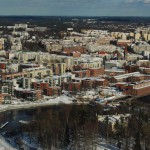Tampere (Finland)
Our latest trip to Finland was made this year in early April. This time, my friends and I decided to explore a few more Finnish cities, and our choice was made in favour of Tampere and Pori.
The Finnish city of Tampere is located between two lakes – Näsiäjrvi in the north and Pyhäjärvi in the south. The lakes are connected through a small river that bears the name Tammerkoski; it divides the historic part of the city into two sections. The length of the river is less than one kilometer, but smart enterprising Finns managed to build a hydro-power station on this small river that supplies the city with electricity.
The climate in Tampere is very close to a temperate marine climate. It is characterized by mild snowy winters and short cool summers. The coldest month of the year is February, and the warmest – July. Snow stays on the ground usually from the end of November till the middle of April.
The history of the foundation of Tampere goes back to the end of the 18th century. In 1775, on the banks of the TammerkoskiRiver, King Gustav III of Sweden founded a market settlement. Four years later, in 1779, the settlement was granted full city rights. At that time Tampere was a little town that spread out for only a few square kilometres.
The official Russian name of the city of Tampere before 1917 was Tammerfors.
In the XIXth century, when Tammerfors, as part of the Grand Duchy of Finland, was one of the cities of the Russian Empire, it had already become a major market and industrial centre. In the second half of the XIXth century, Tammerfors made up almost one half of the industrial potential of Finland. The industrial weight of the city has earned it its second name – Manchester of the North.
Due to the development of industry and construction of the new plants, Tampere increased its territories by joining the neighbouring rural settlements.
In December of 1905, the first conference of RSDRP (Russian Social Democratic Labour Party) took place in Tammerfors, where Lenin and Stalin met for the first time.
Tampere was the scene of one of the most strategically important events during the Civil War in Finland (January 28—May 15, 1918). On April 6, White forces captured the city, seizing about 10,000 Red prisoners.
Tampere was known as the city of textile and metal industries. But in the 1990s, it became known as the centre of telecommunications and information technologies. Hermia Technology Centre in Tampere’s Hervanta district is a representative of this industry.
The major sites of interest in Tampere are the following objects: Tampere Cathedral built in 1907 according to the project of architect Lars Sonck; the Orthodox church of Alexander Nevsky and Saint Nickolas built in 1899 according to the project of Russian engineer T. U. Yazykov; the Lutheran Aleksanterin church, and a recent Modernist concrete temple in the Kaleva district designed by architects Raili and Reima Pietilä and built in 1966.

